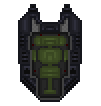Single Occupant Exoatmospheric Insertion Vehicle
The Single Occupant Exoatmospheric Insertion Vehicle (SOEIV), informally known as the drop pod or egg, is a class of Human Entry Vehicle used by the United Nations Space Command to deploy an individual from high orbit to the surface. (Manufactured by Ushuaia Armory, SOEIVs are deployed from orbiting naval vessels and are launched at a particular target, often behind enemy lines. Upon entering a world's atmosphere, a SOEIV employs brakes to slow itself down just short of impact. SOEIVs are primarily operated by the UNSC Marine Corps' Orbital Drop Shock Troopers.
Design details
The Single Occupant Exoatmospheric Insertion Vehicle is an angular pod which vary in size. Within the pod is a crash seat, communications gear, numerous equipment and weapon racks and lockers, and a rudimentary control system that allows for pod maneuvering. A "blunt carriage", a SOEIV has a single entry and escape hatch on one side. There is a braking chute system on the pod's top to slow it down and a reinforced impact plating on the bottom of it to absorb crash impact. The hardened and shielded communications systems within a SOEIV is built directly into the pod's hatch and enables its operator to synchronize deployment with others. In spite of the pod's apparent size, there is not much room for its occupant to move around, as most of the bulk is reserved for heat shielding, electronics, the safety harness, and equipment storage. A SOEIV is coated with ceramic plating, with an alloy crash cage underneath. To allow safe re-entry from high orbit or insertion from deep space, the top of the SOEIV possesses a rocket thruster that also serves as a maneuvering aid during the drop. The top of a SOEIV houses the pod's automated braking chute system, which itself is an extended cable attached to four petal-like flaps. The back of a SOEIV is entirely sealed off and the front often includes a variety of windows—though the latter feature is not present in every model of the pod. A gas-bolt–operated hatch system is incorporated into the pod's front half.
The average SOEIV can vary dramatically in size from pod to pod. Typically, a SOEIV is 2.3 meters (7.5 feet) in length, 2.7 meters (8.9 feet) in width, and 5 meters (16 feet) tall. However, some SOEIVs are approximately 2.74 meters (9.0 feet) in length, 2.6 meters (8.5 feet) wide, and 5.5 meters (18 feet) in height.
Capacity
A Single Occupant Exoatmospheric Insertion Vehicle is only capable of safely holding a single occupant. Each SOEIV contains a variable number of weapons, ammunition, rations, a radio, and can be used as a shelter if need be. Dedicated SOEIV variants exist to deliver supply caches to ground forces, ranging from weapons and ammunition, to small light vehicles such as an M274 ULATV Mongoose, and even a Shiva-class nuclear missile. These SOEIVs are slightly larger in size.
The SOEIV also stores an extra tank of rocket fuel which is not used up in the landing but is rather used for moving to a different location if the vehicle has somehow been knocked off target or is in a currently undesirable location; however, the pod needs must be in the proper upright landing position in order for the booster to be usable.
Operation
Doctrine
In use for nearly a century, SOEIVs allow for the rapid deployment of ground assault troops near or right onto an objective, a method known as "transorbital support interdiction". Their smaller profiles make them more difficult to destroy by defensive fire than conventional dropships. Despite the dangers related to SOEIV deployment, these drop pods have a lower overall casualty rate in combat than conventional dropship deployment. This is largely due to its occupants being conveyed separately, rather than together in one ship. SOEIVs can also be utilized by a spacecraft making a quick pass over a world, allowing for the deployment of hundreds of soldiers in quick succession. Drop pods have also seen use as ballistic projectiles, capable of destroying Blisterback artillery platforms. Each pod bears the name of the soldier inside; amongst other things this identification could be used to identify the unfortunate occupant of a destroyed pod.
UNSC Insertion Protocols call for the commanding officer of an SOEIV-facilitated assault unit to land first to minimize the period of disorder that might occur as pods land and troopers deploy. The reasons for this rule include the strongly held belief that officers should lead rather than follow, should be willing to do anything their troops are asked to do, and should expose themselves to the same level of danger as their subordinates. The commander's pod is equipped with a great deal of equipment that the regular SOEIVs do not possess, including high-powered imaging gear, tactical sensors, and a fourth generation, Class-C military "dumb" artificial intelligence that serves to operate the aforementioned gear.SOEIV usage is popularly associated with the soldiers of the elite Orbital Drop Shock Trooper divisions, although UNSC Special Forces operators and SPARTAN-II supersoldiers are known to use these as one of their primary infiltration methods as well.
